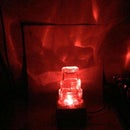Introduction: Handy Photo-frame
- This is a small portable version of a photo-frame which is made just out of an empty matchbox and some waste coloured papers. The project can also be made to develop big photo-frames with the same circuit embedded in it. The circuit doesn't make use of a microcontroller which cuts down the effort to build a separate circuit for it.
The lights in the circuit are controlled by in an infamous circuit named as 'Astable Multivibrator' using two transistors.
For just an idea- an astable multivibrator gives an output voltage as logic HIGH (5 Volts or any positive voltage) for some time and then switches output to logic LOW (0 volts), and this process happens periodically until the switch is closed (or the battery dies!).
This circuit uses the fact that when the output is HIGH, two of the LEDs will glow (here one red and one green on the opposite sides of the frame) and when the output is LOW rest two LEDs will glow.
Materials Required:
- Matchbox (any size)
- 3mm LED x4 (of any colour)
- slide switch
- Foam
- Half A4 size coloured sheets
- Perfboard (zero board)
- 3V button cell and its holder
- 2 Transistors BC547 or 2N2222 (any npn identical transistors will suffice)
- Resistors: 2pc 220ohm, 2pc 100ohm, 2pc 47k ohm
- Capacitors: 2pc of 10uF-(35v or less) (the height should be low as it can fit inside matchbox).
- single strand jumper wires
- solder iron and solder wire
(Resistor values are identified from its colour code, for more details, refer here: https://www.electronics-tutorials.ws/resistor/res_2.html )
Step 1: The Heart - Circuitry
The photo frame has to made according to the size of the matchbox.
The first image is the basic circuit of an Astable Multivibrator. I have modified the circuit to fix the lights and switch as per need, as shown in the second picture.
Now place the parts on the perfboard as per the circuit diagram in the second picture, taking minimum area on it so that it fits inside matchbox without much fuss. In this step, the layout of the components differs from person to person as long as the connections are right.
Placement of LEDs:
The LEDs namely RED1 & GREEN1 should be placed on opposite edges and RED2 & Green2 on the remaining two edges. See pic3 above.
Make sure that the switch is placed such that it protrudes out of the perfboard, as in the end the switch would be controlled when the lever is available outside the frame.
Step 2: Testing Phase
The wires of the LEDs can be extended long enough so that the LEDs are easily fixed around the edges of the matchbox.
Cut the perfboard as per the size of the circuit and place it inside the matchbox. Fill the remaining part of the matchbox with foam for a sturdy body. Make a cavity for button cell holder, if u have a battery holder it would go inside this cavity. I didn't have it so I placed aluminium foil strips on both ends of the cavity and soldered it with jumper wires for connection.
Solder all the connection on the perfboard. Make sure that wires don't short.
Step 3: Cover It All
Put in the battery then open one side of the matchbox lid and cover the circuit. The legs of the LED should remain outside the cover. It will be covered by a coloured sheet later on.
The project is almost done here.
Step 4: Decorate It Well
Take cardboard or hard foam and cut out a rectangular piece (or any shape of your choice, but it should be big enough to cover dimensions of the matchbox) to fix it over matchbox lid. Make small holes through it so that LED can protrude out of it. You can give artistic designs on it.
Cover the sides and base of the box with a long strip of coloured paper (I chose blue) by winding it across the sides. Mark the position of Switch lever. Cut out that much portion from the switch so that the strip completely covers the side. You can also search for 'Net of a cuboid' and build the same to cover the base and sides of the matchbox in one go.
Now paint it or draw designs to give it a great look.
Now paste a nice photograph and turn ON the switch. Have Fun!!
(You can design the same photo frame with more number of LEDs to fill up the borders)




